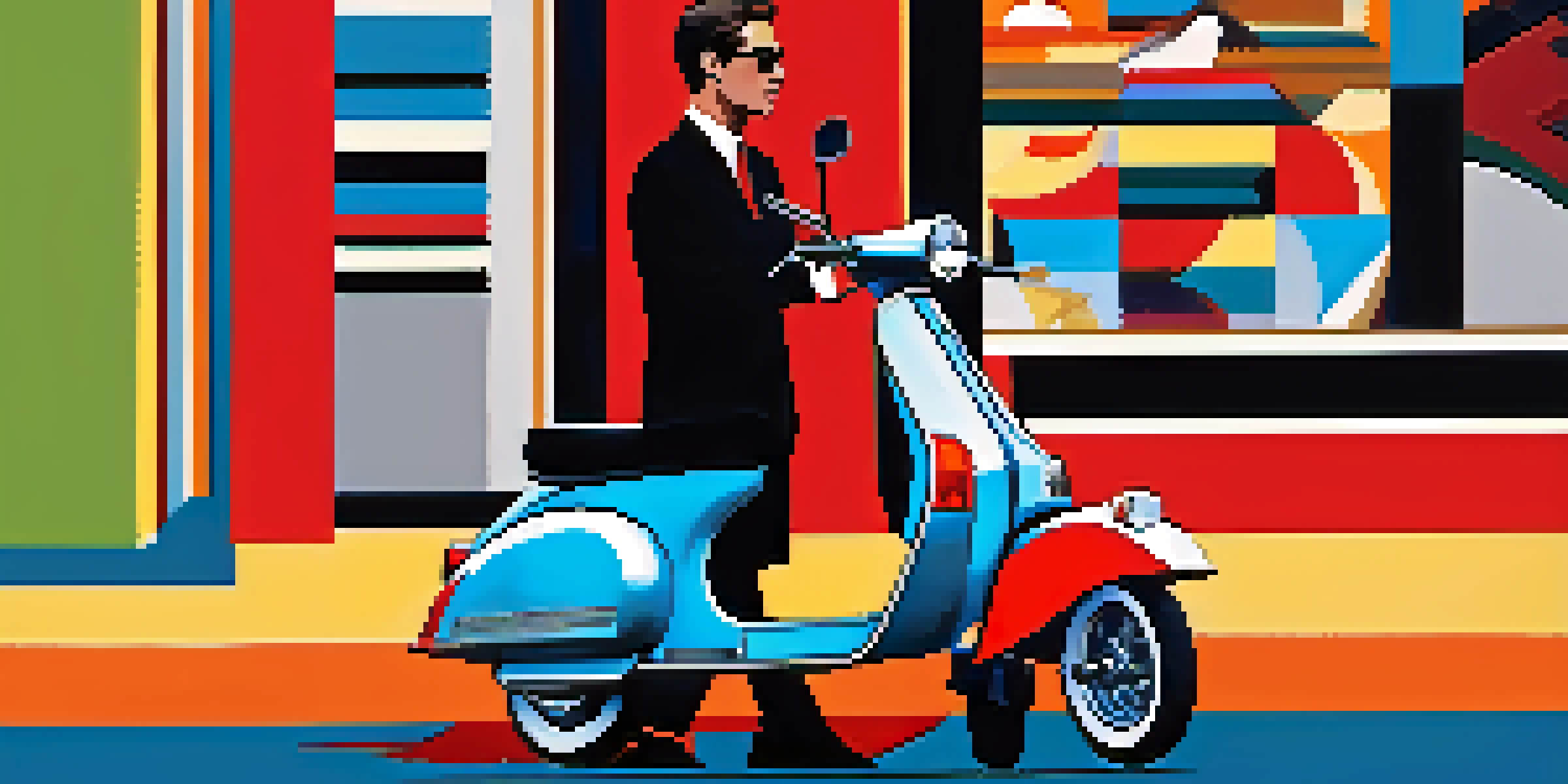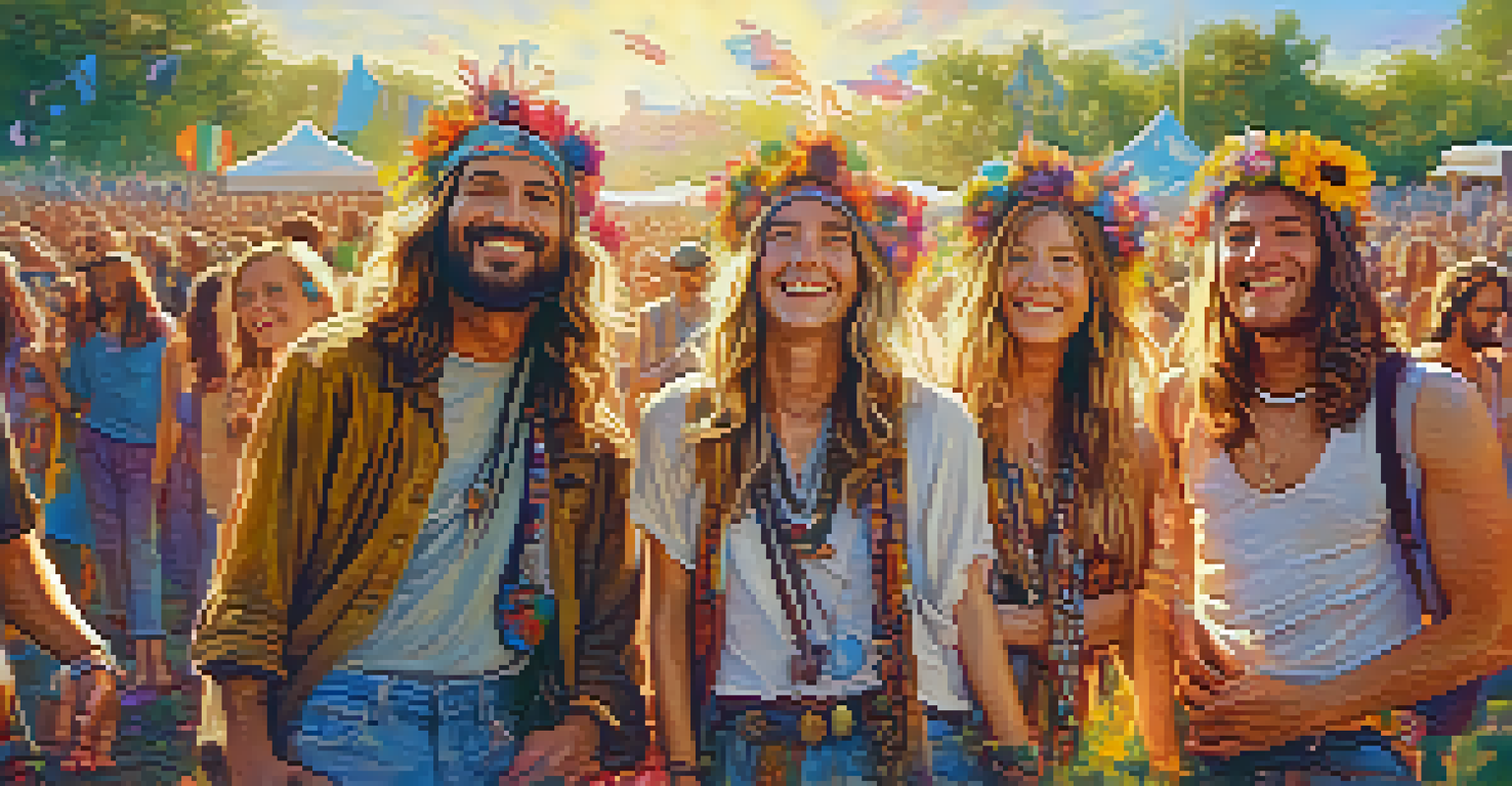The 1960s: From Mod to Hippie, Fashion's Cultural Revolution

The Mod Scene: Style Meets Rebellion
The 1960s kicked off with the emergence of the Mod subculture in Britain. Characterized by tailored suits, bold colors, and geometric patterns, Mods expressed their youthful rebellion against the conservative norms of the previous decade. Think of them as the original trendsetters, crafting a look that was both polished and edgy, with influences from music icons like The Who and The Kinks.
Fashion is the armor to survive the reality of everyday life.
Mods rode scooters and frequented clubs, where they could showcase their distinct fashion and groove to the latest tunes. Their style wasn't just about clothing; it was a lifestyle choice that rejected the status quo. The sharp, clean lines of Mod fashion contrasted sharply with the more relaxed styles that would come later in the decade, illustrating a cultural tension in the air.
This subculture laid the groundwork for future movements, demonstrating how fashion could be a form of self-expression. The Mod look was not just about aesthetics; it was also about identity, community, and the desire for change. This spirit of rebellion would soon evolve, giving way to a more expansive counterculture.
The Rise of the Hippie Movement
As the decade progressed, the Hippie movement began to take shape, bringing with it a radical shift in fashion. Emphasizing peace, love, and anti-establishment sentiments, Hippies adopted a more relaxed and colorful style. Think flowing garments, tie-dye shirts, and bell-bottom jeans—clothing that represented freedom and a break from societal norms.

Hippie fashion was heavily influenced by Eastern cultures, with many incorporating elements like kaftans, sandals, and accessories such as beads and flowers. This fusion of styles not only reflected their beliefs but also their desire for a deeper connection with nature and each other. The iconic flower child look became a symbol of the era, resonating with millions seeking change.
Fashion as Rebellion in the 1960s
The Mod and Hippie movements used fashion as a means of expressing youthful rebellion and challenging societal norms.
What made the Hippie movement particularly captivating was its global reach. From San Francisco's Haight-Ashbury district to the streets of London, the ethos of peace and love transcended borders, uniting people through a shared vision. Fashion became a powerful tool for expressing this collective identity, illustrating how clothing could tell a story far beyond fabric.
Fashion Icons: The Faces of the 1960s Revolution
The 1960s produced a plethora of fashion icons who helped shape and popularize these trends. Figures like Twiggy and Jean Shrimpton personified the Mod look, with their striking features and androgynous styles captivating audiences. Their influence extended beyond the runway, as they became symbols of youth culture and rebellion against traditional femininity.
Clothes mean nothing until someone lives in them.
On the other hand, Hippie icons like Janis Joplin and Jimi Hendrix embraced a more eclectic style, combining vintage finds with handmade pieces. Their fashion choices reflected their artistic spirits and the era's counterculture philosophy. Each outfit told a story, signaling their rejection of mainstream fashion and a call for authenticity.
These icons not only influenced their contemporaries but also left a lasting legacy in the fashion world. Their styles continue to inspire designers and fashionistas today, proving that the spirit of the 1960s is very much alive. Through their clothing choices, they transformed fashion into a language of social change and personal expression.
Music's Role in Shaping Fashion Trends
Music played a pivotal role in the evolution of fashion during the 1960s. As rock and roll, folk, and psychedelic sounds dominated the airwaves, musicians became trendsetters in their own right. Bands like The Beatles and The Rolling Stones not only revolutionized music but also influenced how people dressed, with styles that reflected their evolving identities.
The Beatles' transition from matching suits to colorful, eclectic outfits mirrored the broader cultural changes occurring at the time. Their embrace of Indian fabrics and psychedelic prints showcased a blending of influences, encouraging fans to adopt similar styles. This connection between music and fashion created a powerful feedback loop, where each influenced the other.
Music's Influence on Fashion Trends
Musicians like The Beatles and Jimi Hendrix shaped 1960s fashion, intertwining their evolving styles with the cultural shifts of the era.
As music festivals like Woodstock emerged, they became showcases for Hippie fashion, amplifying its visibility and appeal. The fusion of music and fashion created a vibrant cultural tapestry that defined the decade, demonstrating how closely intertwined these two forms of expression can be. Ultimately, this synergy helped solidify the 1960s as a landmark era for both music and fashion.
The Impact of Political and Social Movements
The 1960s was not just a decade of vibrant fashion; it was also a time of significant political and social upheaval. Movements fighting for civil rights, gender equality, and anti-war sentiments all contributed to the fashion landscape. As individuals sought to express their beliefs through clothing, fashion became a canvas for activism and a means of solidarity.
For example, the black power movement introduced styles that celebrated African heritage, with bold prints and natural hairstyles becoming symbols of pride and resistance. Similarly, the women’s liberation movement saw the rise of practical fashion, with women opting for styles that allowed for greater freedom of movement and self-expression. These choices reflected a desire for equality and a challenge to traditional gender roles.
The intersection of fashion and activism empowered individuals to make statements about their beliefs and values. As people donned clothing that represented their causes, fashion became a form of protest—a way to visually communicate their commitment to change. This cultural revolution highlighted the power of fashion as a tool for social commentary and transformation.
Global Influences on 1960s Fashion
The fashion revolution of the 1960s was not limited to Western cultures; it was deeply influenced by global trends and traditions. As travel became more accessible, individuals began to explore and embrace styles from various cultures. This influx of ideas created a rich tapestry of fashion, with elements from Africa, Asia, and Latin America finding their way into mainstream looks.
For example, the popularity of Indian textiles and patterns transformed Western fashion, as seen in the widespread adoption of kaftans and paisley prints. Similarly, African-inspired designs celebrated heritage and gave rise to vibrant colors and bold silhouettes. These global influences encouraged a more inclusive understanding of fashion, breaking down barriers and stereotypes.
Fashion and Social Activism Unite
The 1960s saw fashion become a canvas for activism, reflecting the political and social movements that sought equality and change.
The cross-cultural exchange during this time also fostered a sense of unity and shared experience. As people donned clothing that reflected diverse cultures, they participated in a broader dialogue about identity and belonging. This cultural exchange helped shape a more interconnected world, illustrating how fashion can bridge divides and celebrate diversity.
The Legacy of 1960s Fashion Today
The fashion revolution of the 1960s has left an indelible mark on contemporary style. Many trends from that era have made a resurgence, with elements like bohemian styles and tailored pieces continually finding their place in modern wardrobes. The spirit of individualism and self-expression that characterized the 1960s continues to inspire today’s designers and fashion enthusiasts alike.
Social media has further amplified this legacy, allowing individuals to share their interpretations of 1960s-inspired fashion. Platforms like Instagram and TikTok have become a playground for showcasing retro styles, proving that the creativity of the past is still relevant. This digital revival highlights how fashion can transcend time, breathing new life into historical trends.

Ultimately, the 1960s serve as a reminder of the power of fashion to inspire change and reflect societal values. As we continue to explore and reinterpret these styles, we honor the legacy of those who used fashion as a tool for expression and rebellion. The cultural revolution of the 1960s remains a vital part of our fashion narrative, shaping how we view style and identity today.